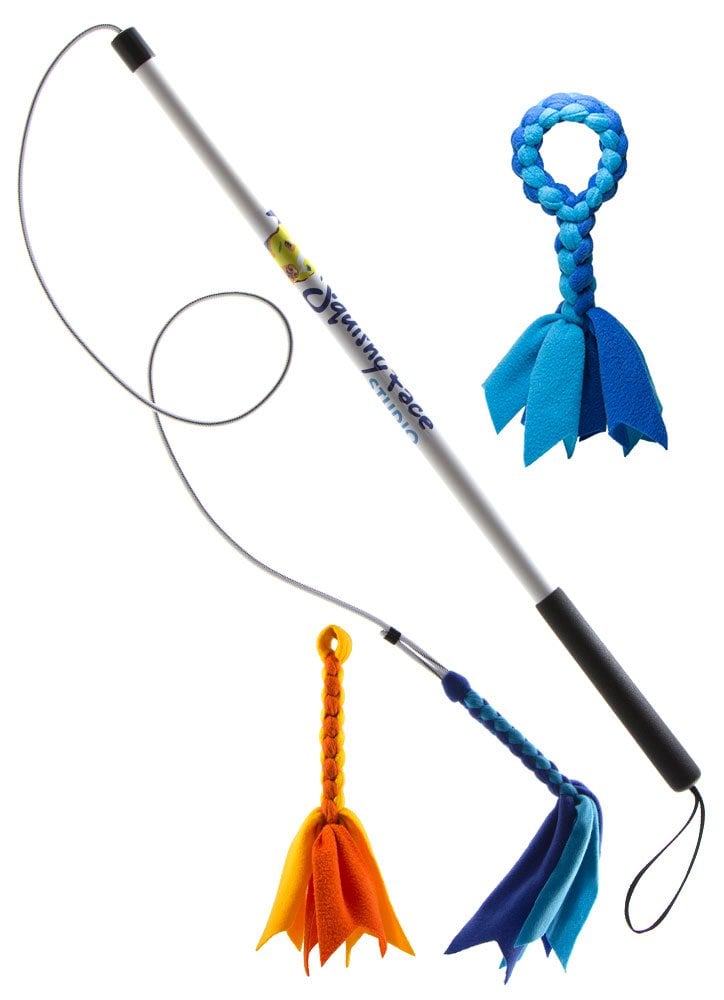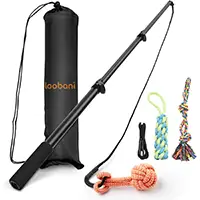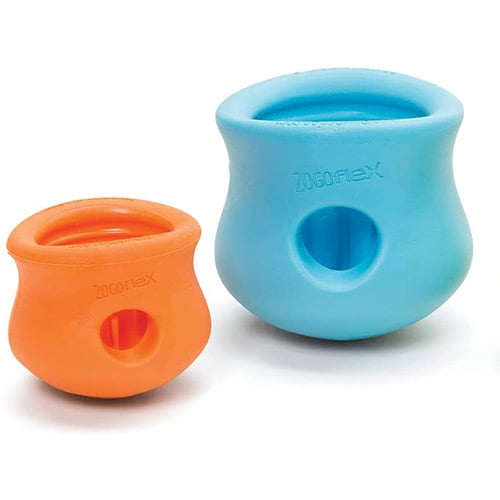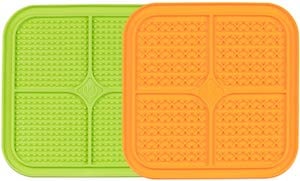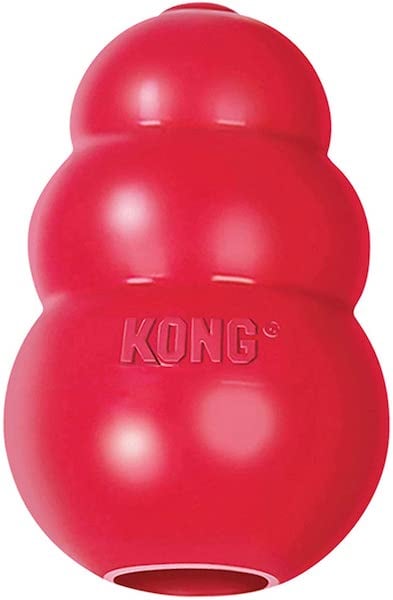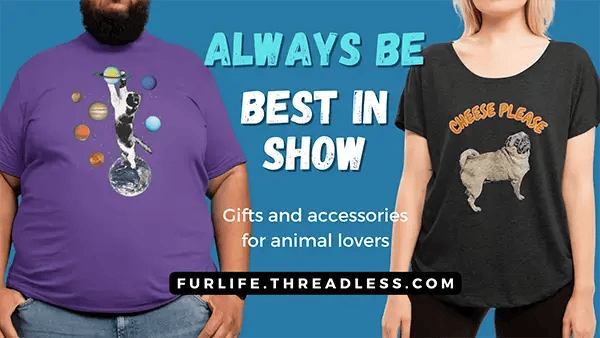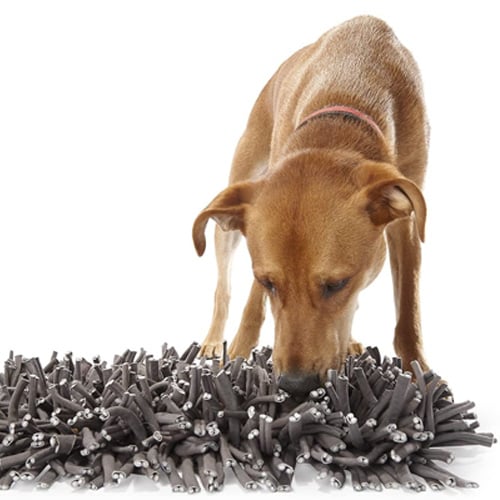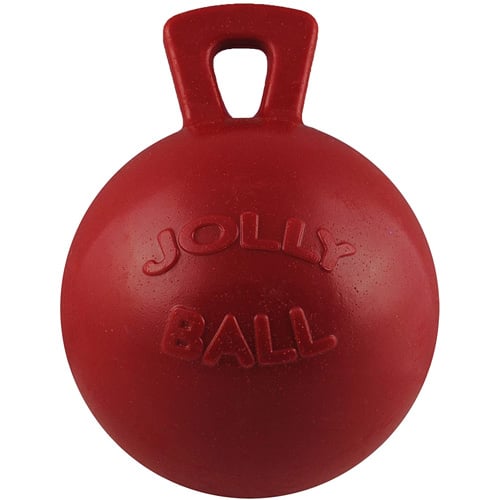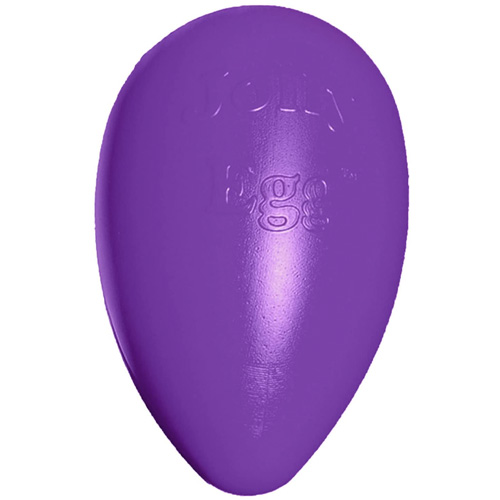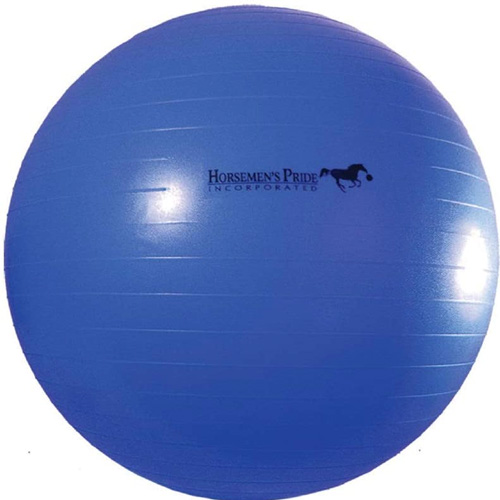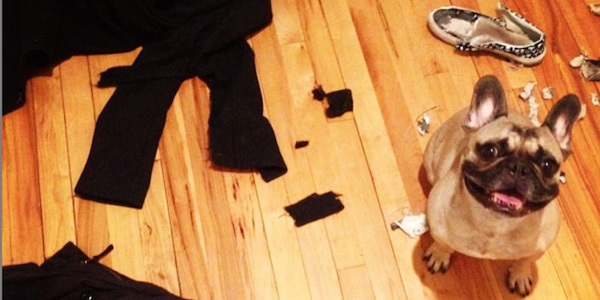 Is your dog barking for no apparent reason? Have they started digging up your flower beds? Is your puppy chewing up your shoes or the couch? Constantly bugging you to interact while you're trying to get some work done?
Is your dog barking for no apparent reason? Have they started digging up your flower beds? Is your puppy chewing up your shoes or the couch? Constantly bugging you to interact while you're trying to get some work done?
In many cases, there is a simple explanation: your dog is bored!
Dogs get bored just like we do, so it's important to provide them with exercise, training, interactive toys, and brain games to keep them busy and entertained.
Giving them appropriate ways to burn that extra energy also means your flower beds, shoes, and couch won't become unfortunate casualties.
To tackle your dog's boredom, don't focus only on physical exercise (although it's important to make sure your pup is staying in shape) — your dog needs mental exercise as well.
Below you'll find some boredom busters to try with your dog, from exercise ideas beyond the regular walk around the block to dog puzzles and DIY brain games. Try out a few with your dog to find out what kind of activities they enjoy the most.
Table of Contents
Take Our Quiz: Enrichment Based on Your Dog's Breed
Increasing mental enrichment for dogs helps reduce boredom and prevent destructive behaviors. Take this quiz to get personalized enrichment ideas for your dog's breed or breed mix:
1. Play with a Flirt Pole
Flirt poles are a great toy that tire out high-energy dogs quickly (and bonus: they can be used in a variety of ways in training).
What exactly is a flirt pole, you ask? Think of it like a larger cat toy or fishing pole. It makes it easier for us humans to play with our dogs without having to run around as much since the pole gives you a way to get your dog chasing after a toy while you can stay stationary.
It does take some practice to get comfortable holding and moving around, but once you've got the hang of it, it's a fun way to engage in play with your dog. If your dog loves chasing after the flirt pole, they might really enjoy lure coursing or FastCAT!
Watch one of our Preventive Vet office pups, Clover the Portuguese Water Dog, learn how to chase the flirt pole and practice her Drop It cue:
DIY Flirt Pole
You can also make your own flirt pole if you want to customize the size. Watch this video to see what you need from the home improvement store and how to make your own:
If you have a puppy or dog under 2 years old, make sure to talk with your veterinarian about the physical exercise you want to do with your dog.
Your vet will guide you to appropriate activities that won't cause long-term damage to your dog's bones and joints (repetitive pressure, like jogging or running, can damage your dog's growth plates).
Young puppies do best with very short sessions of play and exercise — too much and they become exhausted. While a tired dog is a good dog, an exhausted dog is going to be sore and cranky.
2. Play Fetch with Your Dog
A game of fetch is another easy game to tire out your energetic pup, and it doesn't always have to be outdoors. Change up what kind of toys your dog gets to chase and retrieve to keep them interested (you can see our favorite fetch toy picks here).
You can play fetch inside on a rainy day, or while you're working from home if you use one of your dog's favorite stuffy toys or a soft ball.
One fetch game rule everyone should follow is to avoid throwing wood sticks when playing fetch. These can cause injuries such as splinters, punctures, or worse. My corgi loves to play fetch with her very own Fetch Stick.
It bounces and the teal blue color stands out against the grass for her, and it's light enough for her to carry to and from the park. In this video, Clover shows off her fetching skills with the large dog version in red:
Is your dog a little hesitant to play fetch? That's okay! Each dog is different in what games they like to play. You can try Tug-o-War instead, or work on training your dog to play fetch.
3. Go on a Sniffari Walk with your Dog
Have you ever thought about how boring a regular walk can be for your dog? Change it up and try taking your dog on a "sniffari" instead. This kind of walk means letting your dog take the lead and follow their nose wherever it wants to go.
Obviously, you're there to keep a hand on their leash and make sure they don't eat something they shouldn't or wander into dangerous situations like the middle of a street, but allow them the freedom to check out new smells. Let them sniff for as long as they'd like and allow them to choose what direction to go as long as it's safe to do so.
Using their sense of smell is incredibly enriching for dogs, and their brain is processing so much information that it makes these kinds of activities an excellent way to burn excess energy. It's also a great way for your dog (and you) to decompress and lower stress levels.
4. Sign Up for a Dog Sport
Dog sports not only physically exercise your dog, but also provide loads of mental enrichment. There are lots of different dog sports you can get involved in. Try out a few to see which you and your dog enjoy the most. Often there are local dog sport clubs you can join (even if you don't plan on competing and just want to have some fun) and many dog training gyms often offer classes for specific dog sports.
I tried out Barn Hunt with my Cardigan Corgi and not only was he a natural but he was tuckered out after just 4 or 5 runs during practice time! And while we haven't tried out any Barn Hunt competitions quite yet, just trying out a new activity was incredibly enriching for both him and me. Learning new things while having fun? Sign me up!
Here are ten different dog sports to check out:
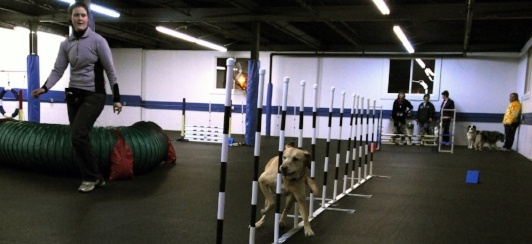
5. Build a Dig Pit for Your Dog
Some dogs just love to dig — especially breeds like Dachshunds or Schnauzers that were originally bred to hunt small critters. Digging is a natural dog behavior and many dogs will dig out of boredom if they have nothing else out in the yard to keep them busy.
In order to save your garden, provide your pup with somewhere they are allowed to dig. You can do this a variety of ways:
- Use a kiddie pool or sandpit container and fill it with kid-safe dirt or sand.
- Designate a specific corner or area of your yard that's okay to dig in. Mark it with small garden dividers to help your dog learn where it's okay to dig.
- Build a raised garden bed filled with dirt or sand.
- Bury some of your dog's toys, treats, or chews in their designated area. Make it easy at first, leaving the toy partially uncovered before burying it completely.
- Explore the dig pit with your dog, getting involved in helping them uncover their buried treasure, and getting excited with them when they unbury things.
- If your dog goes to inappropriate areas and starts to dig, simply redirect them back to their special area. Then consider blocking off their access to the other areas to prevent digging in the wrong spot.
Watch this video to see how easy it is to build your dog their very own dig pit:
6. Use Interactive Dog Puzzles
Feeding your dog out of a regular dog bowl is pretty boring. Dogs are natural foragers, so making them work for their bites of kibble is a great way to work their brain.
Finnegan loves his food puzzle from Loobani. It's less challenging than some other food puzzles but still exercises his brain. The video below shows his first interaction with it. It took about ten minutes to master and then he was ready for a power nap.
If you have a dog that likes to inhale their food at record speeds, using an interactive puzzle for their meals is a great way to slow them down and prevent choking or GDV/Bloat.
My personal favorites are the Toppl from West Paw and the IQ Treat Mat from Hyper Pet. I use these the most with my puppy Fozzie Bear. The Toppl has a larger opening than Kongs, which makes it easy to stuff with a variety of food and treats.
The larger opening is also perfect for puppies still learning how to de-stuff toys or for dogs who might get frustrated if they can't empty out a Kong.
The IQ Treat Mat works wonders in helping my puppy settle down, as repetitive licking has a calming effect for dogs. I mix up what I smear on the mat — from canned pumpkin to peanut butter to his wet food. He usually takes about ten to fifteen minutes to lick it clean. And if I want it to last a bit longer, I'll pop it in the freezer beforehand. After finishing it off, he's always ready for a nice long snooze.
Here's a video of Fozzie Bear trying out the Treat Mat on his first day home with us — it was a great way to introduce him to his "puppy zone" playpen area:
And a true "classic" interactive food puzzle toy is the Kong Classic (which can be stuffed with a huge variety of recipes). Kongs come in a variety of sizes and "chewing strength," with softer options for puppies and seniors. Check out more of our favorite interactive toys in our article "Choosing the Best Interactive Toys and Food Puzzles for Your Dog."
There are lots of these "work-to-eat" toys on the market but you can also make your own pretty easily!
One that you might already have supplies for is this DIY Food Tube Dog Puzzle. You can use your dog's kibble with this puzzle or throw in some Vital Essentials Freeze-Dried Minnows and Zuke's Mini Naturals Treats like we did. Watch how easy it is to make in this video:
Safety Note: Whenever you're making your own puzzles, make sure that they are safe and always supervise their use.
For example, the Food Tube Puzzle should not be used with Brachycephalic (or "flat-faced") dogs, or any other dogs with bulging eyes, as their more prominent eyes are likely to get scratched on the tubes.
This can lead to damage to their corneas (clear surface of their eyeball) requiring medical care. You also don't want your dog chewing up and swallowing any piece of your DIY puzzle that's not meant to be eaten!
7. Incorporate Dog Training Throughout the Day
You can make an easy brain game out of a short and sweet training session with your pup. These training sessions don't need to be very long, 2 to 5 minutes is perfect (even shorter for young puppies!). Read more about why short and sweet training sessions are actually better for training your dog new things.
Some great times to do a training session include:
- Using some of your dog's regular portion of kibble as individual treats at mealtime
- During a commercial break while you're watching television
- Before you start or right after you finish their regular walk.
- Find more ideas on dog training opportunities throughout the day in this article
Watch this video of Mary Berry the Mini-Doodle learning how to Leave It and Stay at the Door to get an idea of how short these training sessions should be:
8. Give Your Dog a Snuffle Mat
A snuffle mat is a fun way to feed your dog their regular meals and work their foraging skills at the same time. My dog loves to root around in the long "grass" for treats and kibble and is learning how to navigate the pockets and other puzzles on her snuffle mat by Difflife.
I love how it keeps her busy for around ten minutes, slows down her eating, and how she usually takes a nap afterward to recover from all that nose work. Watch her in action the first time I set the snuffle mat out for her in this video:
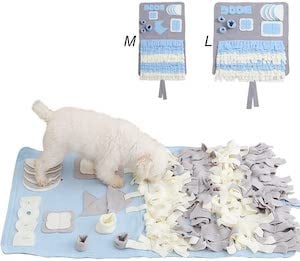
9. Introduce Jolly Balls to Your Dog for Outdoor Play
Many dogs love playing with Jolly Balls in the yard, especially herding breeds. Jolly Balls are a thicker plastic material that won't pop as a basketball or soccer ball would, and there are lots of styles available, from the Original Jolly Ball to a Jolly Egg. You can even introduce your dog to a giant inflatable ball in the backyard that they can herd around and chase. Make sure to purchase an "anti-burst" inflatable ball specifically made for dog or horse play. If your dog loves to chase their Jolly Ball around the yard, you might want to look into trying out some Treibball classes with them.
10. Schedule Regular Dog Play Dates
Interacting and playing with other dogs is wonderful mental enrichment for your pup and maintains their social skills. It's also an easy way to burn extra energy, both physical and mental. Dogs, especially puppies, need practice in learning how to speak dog, which is lots of brain work!
It's important to make sure that all the dogs are having a good time during play, so make sure that you're managing their play and staying aware of the changing dynamics of the group to prevent fights or scuffles from happening. Dog parks aren't for every dog, so don't rely on them for your dog's socialization and exercise (and make sure you know what your puppy needs before going to a dog park). Don't expect your dog to enjoy the dog park either. Many older dogs do better with a familiar playmate, so schedule a "date" for them to hang out with a buddy or go for leashed walks together if they aren't into play as much as when they were young.
These 10 tips are just some ideas to keep your dog from getting bored — let us know in the comments your dog's favorite boredom busters!



